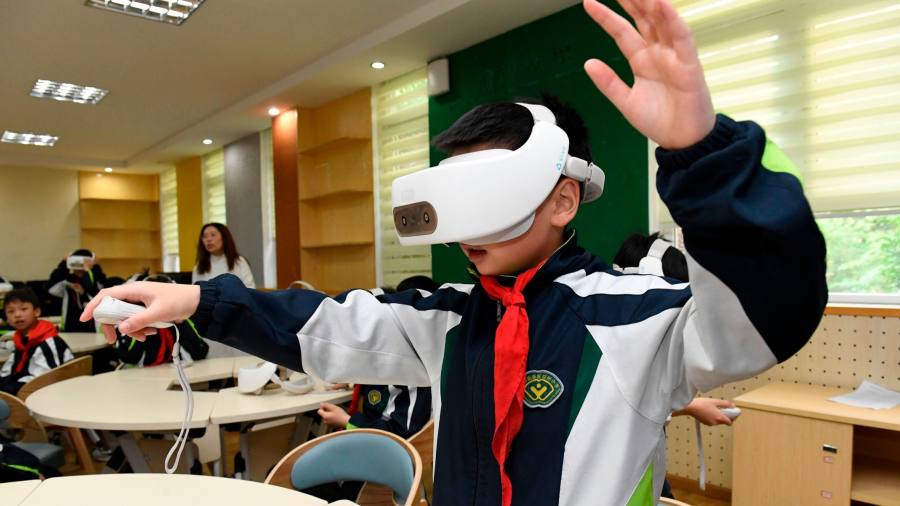
Receive free Education updates
We’ll send you a myFT Daily Digest email rounding up the latest Education news every morning.
Imagine a school where students are taught by the best teachers in every subject, regardless of location. Imagine a school where your children could go on safe field trips to the Amazon rainforest or Everest base camp. Imagine a school where you would not worry about crumbling concrete roofs or murderous shooters. Well, such schools are already being built: in virtual reality.
Last year, the Optima Academy Online launched in Florida promising a liberal arts and sciences curriculum “that improves the hearts and trains the minds of young people delivered through the innovative platform of virtual reality”. Optima delivers courses for elementary, middle and high schools and has enrolled 170 full-time students from all over Florida. In an evolution of home-schooling, students use Meta Quest 2 headsets for about three hours a day for formal lessons and then do course work independently with digital check-ins.
It is worth watching how such educational experiments develop in the light of the so-called Varian Rule of technology diffusion. A simple way to forecast the future, the economist Hal Varian wrote, is to look at what the rich have today and assume that middle-income people will have the same in 10 years and poor people will have it another decade later. Future iterations of VR will doubtless be widely used in education, the only questions are: for what purpose and at what speed?
But there are overwhelming reasons to doubt that VR schools represent the future of education. Sticking a child in their bedroom with a clunky VR headset clamped to their face and no physical social interaction with other kids will fill many of them — and their parents — with horror. VR may yet develop into a creative supplement to traditional learning but it is never going to replace it.
The Optima academy is an extreme example of the surge in “edtech” that resulted from the Covid pandemic lockdowns when, according to Unesco, 1.6bn schoolchildren had their education disrupted. That turmoil accelerated the rapid uptake of online learning as teachers scrambled to teach their students at home. For many children, remote teaching was a lifeline. And there are some extraordinary educational resources available at the click of a mouse. The Khan Academy, which provides free online lessons to millions of students around the world, is one.
A recent report from the Organisation for Economic Cooperation and Development concluded that digital education could significantly enhance the quality, equity and efficiency of schooling systems. But if implemented poorly, it could have the opposite effect, turning a digital divide into an educational one. There is growing evidence to suggest that is happening. In Mexico, according to OECD data, only 24 per cent of 15-year-old students in poor schools have access to a home computer for schoolwork compared with 87 per cent in rich ones. As vividly reported in a recent FT article, some students in northern England have been forced to travel around on the Greater Manchester tram network or camp out in McDonald’s to access free WiFi because they cannot do their school work at home.
In probably the most extensive examination of the global lockdown experience in education, Unesco published a report this week questioning whether the rush to embrace edtech qualified as a “tragedy”. The rapid shift online had resulted in “unchecked exclusion, staggering inequality, inadvertent harm and the elevation of learning models that place machines and profit before people”.
Deployed properly, technology can be fabulous for enabling self-motivated students to access learning resources and connect with fellow students and teachers all over the world, says Beeban Kidron, a member of the UK’s Digital Futures Commission. The trouble is that edtech is too often seen as a shiny new toy that will solve all problems and save money rather than being viewed as a means to enrich learning, she adds.
Schools need to adopt a holistic approach that puts the students’ interests first and blends the best of online and offline learning. The inescapable truth is that there is no substitute for well-motivated teachers educating students in safe schools — ideally, with access to well-designed technological platforms. “Every single piece of long-term research shows that having a good teacher in the classroom is the best way to learn,” Kidron tells me.
For better or worse, we are stuck with reality. Far better to improve it, than try to escape from it.